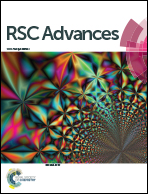Conformal and non-conformal surface modification of honeycomb-patterned porous films via tunable Cassie–Wenzel transition†
Abstract
We describe here a facile and robust approach to conformal and non-conformal surface modification by tuning the wetting transition between the Wenzel state and the Cassie state. Highly ordered honeycomb-patterned porous films were prepared from a diblock copolymer by the breath figure method, and pincushion-like surfaces were obtained by removing the top surface layer of honeycomb films. It is found that the surface modification is highly dependent on the pre-wetting process. After complete pre-wetting, polydopamine (PDA) and polyetherimide (PEI) deposit both inside and outside of the pores, and thus the whole honeycomb film surface becomes hydrophilic. Water droplets on the surfaces transform from a Cassie state to a Wenzel state after 6–12 h PDA/PEI deposition, during which the apparent water contact angles decrease from above 90° (e.g., 115°) to below 90° (e.g., 55°). If the honeycomb-patterned porous films are not pre-wetted, PDA/PEI deposit only on the external surfaces, forming a top layer covering the pores, and the pore walls are not modified. This approach provides a versatile route for controlling water spreading and impregnation behaviors on patterned porous films, which will be useful in fields such as microreactors, supercapacitors, and wearable electronics.


 Please wait while we load your content...
Please wait while we load your content...